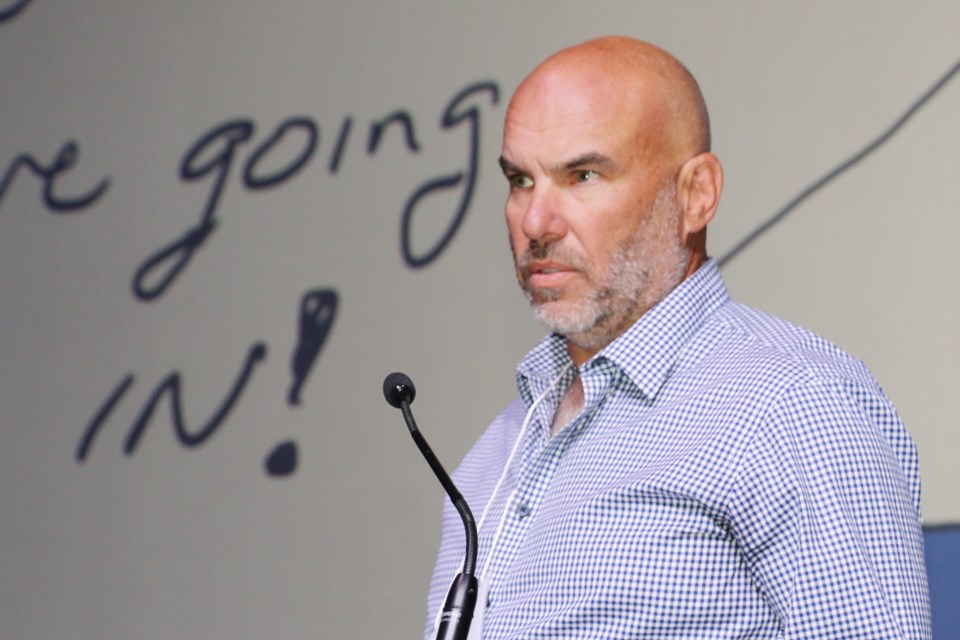The process of going from diesel-powered underground mining to battery-electric mining is now a foregone conclusion for most Northern Ontario mine operators, but there are going to be plenty of growing pains.
That was one of the messages that came out of the Global Mining Guidelines Group forum held in Sudbury on Sept. 12 to examine the job of converting underground mines to full battery electric operations.
Speaker Keith Bowness, the innovation manager at Glencore, talked at length about the many decisions that have to be made in providing all-electric mobile equipment in the new Onaping Depth mine, now being developed below the former Craig Mine.
The title of his talk was “Our First Electrified Mine, and We Are Going All In.”
Bowness said something seemingly as simple as choosing specific mobile equipment and batteries took a significant amount of testing and analysis before choices were made.
As it turned out, he said Glencore chose global mining manufacturer Epiroc as its main fleet supplier, but Glencore also selected MacLean Engineering and Kovatera, companies that both have large Sudbury operations, to supplement the main fleet.
He said having a mixed fleet will present challenges because some of the vehicles will have on-board charging, where the operator plugs in the vehicle to top up the battery power. In other vehicles, such as a large LHD (scooptram) the battery will actually have to be swapped out with a fresh battery halfway through the shift because it uses so much energy.
Bowness said another issue is where to locate combined charging stations in the mine so vehicles can be charged up at the end of a shift. Bowness said discussion was held on whether to have one large charging station to accommodate all battery vehicles or to have several smaller stations located throughout the mine.
"And we've decided that for us, it was best for the infrastructure to minimize the footprint of the infrastructure and have a lot more control if we had one or two of these main swap stations," said Bowness.
He added that this is for the start of the new Onaping Depth mine and things could change over time as the mine goes deeper.
Bowness added that the depth of the new Onaping mine has played a significant role in the decision to go to electric vehicles. As the mine moves below 2,000 metres, the temperature of the rock face rises to about 45 Celsius. Bowness said that would make it difficult to run diesel powered trucks and scoops, which would add to the heat and add to the cost of ventilation to bring fresh air into the lower levels of the mine.
"And it's going to need refrigeration. The rock mass temperature, just as you blast, will be at 45 degrees C, so it's going to be warm. So we're putting in a large refrigeration plant on the 1,915 (metre) level. But one of the things about this is that the amount of ventilation that you need in here is extensive and very expensive, and that was what was stopping you from actually becoming a mine when we first did the study, was the expense of actually trying to extract the ore," he said.
Bowness said the cost of fresh-air ventilation, powered by huge electric fans, is such that Glencore has opted to shrink the actual dimensions of the drift headings (tunnel size). He said Glencore decided to reduce the size of headings from 5.5 metres by 5.5 metres down to 4.6 by 4.6. He said one group of people did the math and predicted good results.
"If you have ventilation, you could reduce (the amount needed) by about 120 cubic meters per second (by shrinking the drift headings). Your shaft diameter, you can actually shrink it because you don't need to push all that air down,” Bowness said. “When you're looking at the return air raise-diameters, they also shrink. Refrigeration goes down and then the ventilation fan power requirements you can see goes from 10,900 kilowatts down to 6,100 kilowatts. That's a significant savings when it comes to ventilation.”
He added that the Onaping Depth project qualifies for several government incentive programs because it is environmentally sound and innovative.
Bowness said the Onaping project would be sustainable, regardless.
"Yes, there's a lot of government incentives, and I like to go with green energy and all that. But this project stands alone just based on its economics. And it doesn't really necessarily require a lot of government intervention to try to make it go. So what I'm saying though, is if the government programs were to dissolve tomorrow, this project is still sustainable based on the merits of economics."
Heather Ednie, the CEO of the Global Mining Guidelines Group (GMG) said the Sudbury forum was an exercise in collaboration and cooperation and that was a key reason for bringing so many local companies to the venue to share information.
"A GMG forum has got a sort of a two-fold reason or purpose,” Ednie said. “One is to help our working groups and project information get out into the industry, and the other one is just to enable this collaboration.
“And then you have a forum where people can find peers from other companies and share their ideas, and then we collect feedback from our project groups."
Ednie said she could not speak for other industries but the sharing of new information is happening because there is so much change going on in mining right now.
“My guess is that mining has gotten much more collaborative in the last decade. Yeah, mining is undergoing transformational change. And to do that in an industry this small, you need to work together to have that sort of the might to move forward."
Len Gillis covers mining and health care for Sudbury.com.




